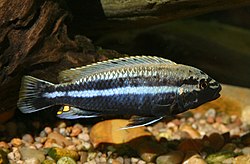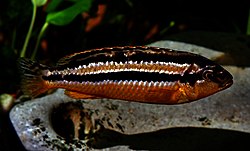| Melanochromis auratus | |
|---|---|
 | |
| An adult male auratus cichlid | |
 | |
| An adult female auratus cichlid | |
| Scientific classification | |
| Kingdom: | Animalia |
| Phylum: | Chordata |
| Class: | Actinopterygii |
| Order: | Cichliformes |
| Family: | Cichlidae |
| Genus: | Melanochromis |
| Species: | M. auratus |
| Binomial name | |
| Melanochromis auratus (Boulenger, 1897) | |
 | |
| Synonyms | |
| |
Melanochromis auratus, the auratus cichlid, is a freshwater fish of the cichlid family. It is also known as golden mbuna and Malawi golden cichlid. It is endemic to the southern region of Lake Malawi, particularly from Jalo Reef southward along the entire western coast down to Crocodile Rocks.
